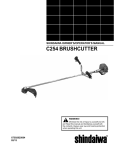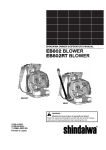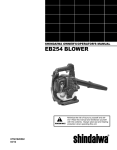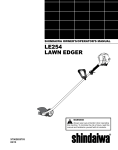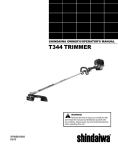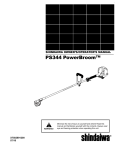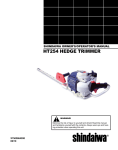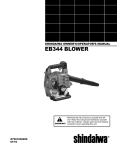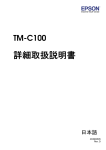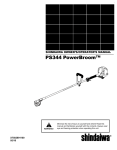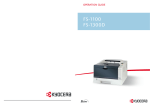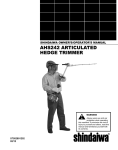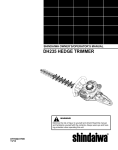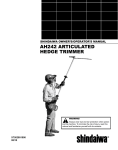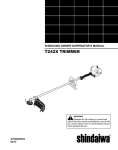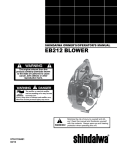Download Shindaiwa X7506720300 Operator`s manual
Transcript
English Shindaiwa OWNER’S/OPERATOR’S MANUAL GP344 WATER PUMP WARNING! X7506720300 07/10 Minimize the risk of injury to yourself and others! Read this manual and familiarize yourself with its contents! Always wear eye and hearing protection when operating this unit. Introduction This Shindaiwa GP344 water pump has been designed and built to deliver superior performance and reliability without compromise to quality, comfort, or durability. Shindaiwa high performance engines represent the leading edge of 4-cycle engine technology, delivering exceptionally high power at remarkably low displacement and weight. As an owner/ operator, you’ll soon discover why Shindaiwa is simply in a class by itself! Contents IMPORTANT! The information contained in this manual describes units available at the time of production. While every attempt has been made to give you the very latest information about your Shindaiwa GP344 water pump, there may be some differences between your pump and what is described here.Shindaiwa Inc. reserves the right to make changes in production without prior notice, and without obligation to make alterations to units previously manufactured. PAGE Safety.............................................. 3 Unit Description............................... 4 Specifications.................................. 4 Assembly......................................... 5 Mixing fuel....................................... 6 Echo, Inc. reserves the right to make changes to products without prior notice, and without obligation to make alterations to units previously manufactured. IMPORTANT! The information contained in these instructions describes units available at the time of publication. WARNING! The engine exhaust from this product contains chemicals known to the State of California to cause cancer, birth defects or other reproductive harm. PAGE PAGE Filling the fuel tank.......................... 6 Starting the Engine.......................... 7 Adjusting Engine Idle....................... 8 Operation......................................... 9 Maintenance.................................. 10 Long Term Storage........................ 13 Troubleshooting Guide.................. 13 Emission System Warranty........... 17 IMPORTANT! The operational procedures described in this manual are intended to help you get the most from this unit as well as to protect you and others from harm. These procedures are guidelines for safe operation under most conditions, and are not intended to replace any safety rules and/or laws that may be in force in your area. If you have questions regarding your H4 series hand-held power equipment, or if you do not understand something in this manual, contact Shindaiwa Inc. at the address printed on the back of this Manual. Attention Statements Throughout this manual are special “attention statements”. DANGER! A statement preceded by the triangular attention symbol and the word “DANGER” contains information that should be acted upon to prevent serious injury or death. WARNING! A statement preceded by the triangular attention symbol and the word “WARNING” contains information that should be acted upon to prevent serious bodily injury. IMPORTANT! A statement preceded by the word “IMPORTANT” is one that possesses special significance. Operational and warning labels Read and follow this Owner’s/ Operator’s Manual. Failure to do so could result in serious injury. Wear eye and hearing protection at all times during the operation of this unit. 2 To avoid water pump damage, fill priming port with water before use. WARNING: Surface can be hot. Always wear gloves when handling this unit. HOT SURFACE CAUTION! A statement preceded by the word “CAUTION” contains information that should be acted upon to prevent mechanical damage. NOTE: A statement preceded by the word “NOTE” contains information that is handy to know and may make your job easier. Safety Work Safely Pumps operate at very high speeds and can do serious damage or injury if they are misused or abused. Never allow a person without training or instruction to operate this unit! WARNING! Never make unauthorized attachment installations. Stay Alert You must be physically and mentally fit to operate this unit safely. WARNING! Never operate power equipment of any kind if you are tired or if you are under the influence of alcohol, drugs, medication or any other substance that could affect your ability or judgement. WARNING! Use Good Judgment NEVER operate the engine when transporting the unit. NEVER operate the engine indoors! Make sure there is always good ventilation. Fumes from engine exhaust can cause serious injury or death. ALWAYS stop the unit immediately if WARNING! Minimize the Risk of Fire NEVER smoke or light fires near the unit. ALWAYS stop the engine and allow it to cool before refueling. Avoid overfilling and wipe off any fuel that may have spilled. ALWAYS inspect the unit for fuel leaks before each use. During each refill, check that no fuel leaks from it suddenly begins to vibrate or shake. Inspect for broken, missing or improperly installed parts. ALWAYS keep the unit as clean as practical. Keep it free of loose vegetation, mud, etc. ALWAYS disconnect the spark plug wire before performing any maintenance work. around the fuel cap and/or fuel tank. If fuel leaks are evident, stop using the unit immediately. Fuel leaks must be repaired before using the unit. ALWAYS move the unit to a place well away from a fuel storage area or other readily flammable materials before starting the engine. NEVER place flammable material close to the engine muffler. NEVER run the engine without the spark arrester screen in place. Safety labels IMPORTANT! HOT SURFACE Caution, Danger, Warning, and Operation Information Labels: Make sure all information labels are undamaged and readable. Immediately replace damaged or missing information labels. New labels are available from your local authorized Shindaiwa dealer. 3 Unit Description Filler Plug Spark Plug Discharge Connection Air Cleaner Priming Port Recoil Starter Handle Filler Plug Handle Throttle Lever Priming Port Discharge Connection Fuel Filler Cap Muffler Suction Connection Choke Fuel Tank Fuel Tank Stop Switch Using the illustrations above as a guide, familiarize yourself with this unit and its various components. Understanding the unit helps ensure top performance, long service life, and safer operation. Specifications Drain Plug Model Engine Type Displacement GP344 4 cycle air-cooled gasoline engine, vertical cylinder 34 cc (38mm x 30mm); 2.07 cu. in. (1.50 x1.18 in.) Fuel/Oil Ratio Carburetor Ignition Spark Plug 50:1 with *ISO-L-EGD or JASO FD class engine oil Walbro rotary type with primer bulb PCI NGK CMR5H 0.6 mm / 0.024 inch 16.7 - 18.6 N∙m / 148 -165 in • lbs Recoil starter Push button 22.4 oz. (0.6661 liter) 15.6 pounds (7.1 kg) 3,000 RPM N/A 7,500 RPM Plug Gap Torque Starting Stopping Fuel tank capacity Weight Engine Idle Speed Clutch Engagement Speed Wide Open Throttle Speed (W.O.T.) Pump Type Suction Diameter Discharge Diameter Maximum Suction Head (vertical lift) Maximum Total Pump Head Maximum Pump Discharge General purpose, centrifugal, self-priming 1.0 inches (25mm) 1.0 inches (25mm) 26.25 feet (8 meters) 157 feet (48 m) 34.8 gal/min (132 liters/min) Specifications are subject to change without notice. IMPORTANT This spark ignition system complies with the Canadian standard ICES-002. 4 Emission Control (Exhaust & Evaporative) EPA 2010 and Later and/or C.A.R.B. TIER III The emission control system for the engine is EM/TWC (Engine Modification and 3-way Catalyst) and for the fuel tank the Control System is EVAP (Evaporative Emissions) or N (for nylon tank). Evaporative emission may be applicable to California models only. An Emission Control Label is located on the unit. (This is an EXAMPLE ONLY; information on label varies by engine FAMILY). PRODUCT EMISSION DURABILITY (EMISSION COMPLIANCE PERIOD) The 300 hour emission compliance period is the time span selected by the manufacturer certifying the engine emissions output meets applicable emissions regulations, provided that approved maintenance procedures are followed as listed in the Maintenance Section of this manual. Assembly Prior to Assembly Before assembling this unit, make sure you have all the components required for a complete unit: ■■GP344 engine-driven pump ■■Spanner ■■3mm Hex Wrench ■■4mm Hex Wrench ■■Parts bag including: ■■ 1.0" hose clamps (3 each) ■■ hose fittings and gaskets ■■ ■■ ■■Spark plug wrench Install the Suction and Discharge Hoses CAUTION! Priming Port ■■This pump is intended for pumping fresh water only. ■■Ingested debris can damage the pump impeller and seals. ■■Never operate the pump if the strainer is missing or damaged. 1. Assemble a barbed hose fitting, ring nut, and gasket as shown, and thread the completed hose fitting assembly onto the pump suction port. 2. Push a 1.0" suction hose (not provided) over the suction hose fitting on the pump body, and secure with a 1.0" hose clamp as shown. Working at the opposite end of the suction hose, use a second 1.0" hose clamp to install and secure the suction strainer. 3. Submerge the suction hose strainer in the water source. For maximum performance, avoid placing the strainer directly in heavy accumulations of leaves, silt, or other debris. (2 each) strainer garden hose adapter (use garden hose only to discharge water!) Discharge Port Gasket Ring Nut Suction Port Hose Clamp Barbed Hose Fitting Suction Hose Hose Clamp Assembling the hoses 4. Install the discharge hose (not provided) using the garden hose adapter. 5. Recheck that both the suction and discharge hoses are free from obstructions, and that all connections are tightly secured. Suction Strainer IMPORTANT! Place the pump as close to the water source as possible. Increases in suction lift will lower pump performance. Do not exceed maximum suction head of 26 feet. 5 Priming Before the pump can develop suction or “lift” at the water source, the pump impeller must first be primed by filling the pump housing with water. Once the water pump has been primed, additional priming should be required only if the pump has been drained or otherwise emptied. 1. Remove the filler plug at the top of the pump housing. Use care not to lose the sealing ring beneath the filler plug. 2. Fill the pump housing through the priming port with clean water until water overflows from the filler plug hole on the pump body. 3. Replace and securely tighten the filler plug. Filler plug Sealing ring CAUTION! Never allow the pump to run dry! Operation without water can permanently damage the pump seals. IMPORTANT! A damaged or missing filler plug seal may allow air to leak into the pump housing. Air leakage can lower performance! Priming port Mixing Fuel WARNING! Alternative fuels, such as E15 (15% ethanol), E-85 (85% ethanol) or any fuels not meeting Shindaiwa requirements are NOT approved for use in Shindaiwa gasoline engines. Use of alternative fuels may cause performance problems, loss of power, overheating, fuel vapor lock, and unintended machine operation, including, but not limited to, improper clutch engagement. Alternative fuels may also cause premature deterioration of fuel lines, gaskets, carburetors and other engine components. Fuel Requirements Gasoline - Use 89 Octane [R+M/2] (mid grade or higher) gasoline known to be good quality. Gasoline may contain up to 10% Ethanol (grain alcohol) or 15% MTBE (methyl tertiary-butyl ether). Gasoline containing methanol (wood alcohol) is NOT approved. Hybrid 4TM Mixture Oil - Engine oil meeting ISO-L-EGD (ISO/CD 13738) and J.A.S.O. M345/FD standards must be used. Shindaiwa highly recommends using Shindaiwa Red ArmorTM engine oil in all Shindaiwa Hybrid 4TM engines to protect the engine from harmful carbon build up, maintain engine performance, and increase engine life. Shindaiwa Red ArmorTM engine oil exceeds ISO-L-EGD and J.A.S.O. M345/FD performance requirements. Engine problems due to inadequate lubrication caused by failure to use an ISO-L-EGD (ISO/CD 13738) and J.A.S.O. M345/FD certified oil will void the engine warranty. IMPORTANT! Shindaiwa Red ArmorTM engine oil may be mixed at 50:1 ratio for application in all Shindaiwa engines sold in the past, regardless of ratio specified in those manuals. IMPORTANT! Stored fuel ages. Do not mix more fuel than you expect to use in thirty (30) days, ninety (90) days when a fuel stabilizer is added. Use of unmixed, improperly mixed, or stale fuel, may cause hard starting, poor performance, or severe engine damage and void the product warranty. Read and follow instructions in the Long Term Storage section of this manual. 6 Examples of 50:1 mixing quantities Handling Fuel DANGER Fuel is VERY flammable. Use extreme care when mixing, storing or handling or serious personal injury may result. • Use an approved fuel container. • DO NOT smoke near fuel. • DO NOT allow flames or sparks near fuel. • Fuel tanks/cans may be under pressure. Always loosen fuel caps slowly allowing pressure to equalize. • NEVER refuel a unit when the engine is HOT or RUNNING! • DO NOT fill fuel tanks indoors. ALWAYS fill fuel tanks outdoors over bare ground. • DO NOT overfill fuel tank. Wipe up spills immediately. • Securely tighten fuel tank cap and close fuel container after refueling. • Inspect for fuel leakage. If fuel leakage is found, do not start or operate unit until leakage is repaired. • Move at least 3m (10 ft.) from refueling location before starting the engine. Mixing Instructions 1. Fill an approved fuel container with half of the required amount of gasoline. 2. Add the proper amount of engine oil to gasoline. 3. Close container and shake to mix oil with gasoline. 4. Add remaining gasoline, close fuel container, and remix. IMPORTANT! Spilled fuel is a leading cause of hydrocarbon emissions. Some states may require the use of automatic fuel shutoff containers to reduce fuel spillage. After use • DO NOT store a unit with fuel in its tank. Leaks can occur. Return unused fuel to an approved fuel storage container. Storage - Fuel storage laws vary by locality. Contact your local government for the laws affecting your area. As a precaution, store fuel in an approved, airtight container. Store in a well-ventilated, unoccupied building, away from sparks and flames. IMPORTANT! Stored fuel may separate. ALWAYS shake fuel container thoroughly before each use. Filling the fuel tank WARNING! Minimize the Risk of Fire ■■NEVER smoke or light fires near the engine. ■■ALWAYS stop the engine and allow it to cool before refueling. ■■ALWAYS Wipe all spilled fuel and move at least 3 meters (10 feet) from the fueling point and source before starting. ■■NEVER place flammable material close to the engine muffler. ■■NEVER operate the engine without the muffler and spark arrester screen in place and in good working condition. ■■FUEL IS HIGHLY FLAMMABLE. ■■ALWAYS store gasoline in a container approved for flammable liquids. ■■ALWAYS inspect the unit for fuel leaks before each use. During each refill, check that no fuel leaks from around the fuel cap and/or fuel tank. If fuel leaks are evident, stop using the unit immediately. Fuel leaks must be repaired before using the unit. ■■ALWAYS move the unit at least 3 meters (10 feet) away from a fuel storage area or other readily flammable materials before starting the engine. 1. Place the unit on a flat, level surface. 2. Clear any dirt or other debris from around the fuel filler cap. CAUTION! Slowly remove the fuel cap only after stopping the engine 3. Remove the fuel cap, and fill the tank with clean, fresh fuel. 4. Reinstall the fuel filler cap and tighten firmly. 5. Wipe away any spilled fuel before starting engine. 7 Starting the Engine WARNING! D Do not run engine in an enclosed area. Exhaust gas contains carbon monoxide, an odorless and deadly poison. Return tube IMPORTANT!. Do not start or run the pump without priming the pump with water. Serious damage to the pump seals will occur when the pump is run dry. Primer bulb 1. Place suction intake and strainer in the water to be pumped prior to starting engine. 2. Set throttle control lever to the half open position. See Figure 3. 3. Press the primer bulb until fuel can be seen flowing in the transparent return tube. See Figure 4. IMPORTANT! The primer system only pushes fuel through the carburetor. Repeatedly pressing the primer bulb will not flood the engine with fuel. Figure 4 Figure 3 Close L Figure 6 Figure 5 4. Set the choke lever to the CLOSED position if the engine is cold. IMPORTANT! 5. While holding the pump handle firmly with your left hand, use your other hand to slowly pull the recoil starter handle until resistance is felt, then pull quickly to start the engine. See Figure 6 CAUTION! Do not pull the recoil starter to the end of the rope travel. Pulling the recoil starter to the end of the rope travel can damage the starter. 6. When the engine starts, slowly move the choke lever to the "OPEN" position. See Figure 7. (If the engine stops after the initial start, close the choke and restart.) Open Figure 7 7. When the engine starts, gradually move the throttle control lever back to the idle position (counterclockwise). If the engine fails to start after several attempts with the choke in the closed position, the engine may be flooded with fuel. If flooding is suspected, move the choke lever to the open position and repeatedly pull the recoil starter to remove excess fuel and start the engine. If the engine still fails to start, refer to the troubleshooting section of this manual. 8. After the engine starts, allow the engine to warm up at idle 2 or 3 minutes before operating the unit. 9. Place throttle lever (D) in half throttle position until pump begins to pump water. Then move lever to full throttle. If the engine does not start 1. Repeat the appropriate procedures for starting a warm or cold engine. 2. If the engine fails to start, follow the procedures in “Starting a Flooded Engine”. Starting A Flooded Engine 1. Open the choke, put the throttle trigger in the full throttle position, then clear excess fuel from the combustion chamber by cranking the engine several times. 2. If the engine still fails to start or fire, refer to the troubleshooting flow chart at the end of this manual. 8 Stopping the Engine 1. Move throttle lever (D) towards engine to idle position and allow engine to return to idle before shutting engine off. 2. Push the red ignition switch until the engine completely stops. See Figure 8. Ignition Switch Figure 8 Operation Operating Tips for Maximum Performance CAUTION! Sudden pressure increases (such as from vehicles driving on the discharge hose) can split the discharge hose and may also damage the pump body. Keep the suction lift distance as short as possible. Minimize clogging from debris: Place the suction strainer on a bed of stones or tied in a bucket. Figure 12 ■■Always wear eye protection such WARNING! as goggles or safety glasses. ■■Keep all pets and bystanders away from the pump during operation and fueling. ■■Beware the pump may shift suddenly during operation, especially when the hoses first fill with water. ■■Do not wear loose clothing, jewelry, or long hair that could get caught in machinery. Total head (meters) 1. Minimize friction by using the correct 1.0" ID suction and discharge hoses specified, with a minimum of connections. Keep all hose runs as short as possible. 2. Keep the suction head (vertical lift) as short as possible. Do not exceed the pump’s maximum suction head of 26 feet. 3. Avoid air leaks. a. All suction-side connections must be tightly secured. b. Make sure the filler cap and drain plug on the pump housing are tight and free from leakage. 3. Protect the discharge hose from crushing-type damage, especially from motor vehicles. 4. Abrasive debris can damage the pump impeller and seals, and should be avoided. 5. To minimize clogging the strainer when pumping near mud or debris, place the strainer in a bucket or on a bed of stones. 50 45 40 35 30 25 20 15 10 5 devices when operating this unit. ■■Wear appropriate footwear such as nonskid boots or shoes. Steeltoed rubber boots are strongly recommended. NEVER WORK BAREFOOT! ■■Gloves are recommended. The higher the lift, the less the discharge quantity. 0 Figure 11 ■■Always wear hearing-protection 50 100 150 200 250 Discharge Quantity ( liters per minute) 300 Be careful when locating the pump; the pump may shift suddenly during operation! Protect the discharge hose from crushing. 9 WARNING! ■■Burn danger/Danger from spilled ■■Danger from moving parts! The fuel! Always stop the pump engine before transporting the pump. The engine muffler and other components may be very hot during or after pump operation. Carry the pump by the handle only. The pump must remain level at all times. ■■Danger of Asphyxiation! This pump is intended for outdoor use in well ventilated areas only! pump rotor will rotate whenever the engine is cranked or operated. Stop the engine and disconnect the spark plug terminal before performing any maintenance or installations on this pump. Never operate this pump unless all covers and shields are in place, and both the suction and discharge hoses are installed and firmly connected to the pump. ■■Explosion Hazard! Never attempt to start or operate this pump in the presence of explosive or combustible materials! ■■Never attempt to transfer fuels or other hazardous liquids with the water pump! This pump is designed and warranted for pumping FRESH WATER ONLY! Maintenance General maintenancel IMPORTANT! MAINTENANCE, REPLACEMENT OR REPAIR OF EMISSION CONTROL DEVICES AND SYSTEMS MAY BE PERFORMED BY ANY REPAIR ESTABLISHMENT OR INDIVIDUAL; HOWEVER, WARRANTY REPAIRS MUST BE PERFORMED BY A DEALER OR SERVICE CENTER AUTHORIZED BY ECHO, INC. THE USE OF PARTS THAT ARE NOT EQUIVALENT IN PERFORMANCE AND DURABILITY TO AUTHORIZED PARTS MAY IMPAIR THE EFFECTIVENESS OF THE EMISSION CONTROL SYSTEM AND MAY HAVE A BEARING ON THE OUTCOME OF A WARRANTY CLAIM. NOTE: Using non-standard replacement parts could invalidate your Shindaiwa warranty. Daily Maintenance Prior to each work day, perform the following: ■■Remove dirt or debris from the engine, check the cooling fins and air cleaner for clogging and clean them as necessary. 10 WARNING! Before performing any maintenance, repair, or cleaning work on the unit, make sure the engine and cutting attachment are completely stopped. Disconnect the spark plug wire before performing service or maintenance. Muffler This unit must never be operated with a faulty or missing spark arrester or muffler. Make sure the muffler is well secured and in good condition. A worn or damaged muffler is a fire hazard and may also cause hearing loss. Spark Plug Keep the spark plug and wire connections tight and clean. Fasteners Make sure nuts, bolts, and screws (except carburetor adjusting screws) are tight. ■■Carefully remove any accumulation of dirt or debris from the muffler or the fuel tank. Dirt build-up in these areas could cause engine overheating, induce premature wear, or create a fire hazard. WARNING! Non-standard accessories, cutting attachment, or replacement parts may not operate properly with your unit and may cause damage and lead to personal injury. Air Filter The H4 engine that powers your Shindaiwa model is a hybrid 4-stroke engine. As a hybrid, the engine is lubricated by oil mixed with the gasoline and air from the carburetor that moves through and around the internal parts of the engine in a similar way that a 2-stroke engine is lubricated. Without the heavy duty 2-stage air filter equipped on all H4 engines, dust and dirt could also move through the engine, decreasing engine life, increasing valve wear and the need for more frequent valve adjustments. To keep your H4 engine strong and reliable, Shindaiwa recommends that you check and service the air filter as instructed in the 10-Hour Maintenance section that follows. ■■Check for loose or missing screws or components. ■■Check the entire unit for leaking fuel. ■■Inspect the suction and discharge hoses for damage, clogging, or loose connections, and clean or repair as necessary. Maintenance (continued) 10-Hour Maintenance (more frequently in dusty conditions) 1. Remove the air filter cover by loosening the two thumbscrews. See Figure 13A. 2. Remove and inspect the pre-filter. If the pre-filter is torn or otherwise damaged, replace it with a new one. See Figure 13B. 3. Clean the pre-filter with soap and water. Let dry before reinstalling. 4. Inspect the air filter element. If the element is damaged or distorted, replace it with a new one. 5. Tap filter gently on a hard surface to dislodge debris from element or use compressed air from the inside to blow debris out and away from the air filter element. Loosen thumbscrews Pre-filter Filter Element Figure 13A Figure 13B 6. Install the filter element, pre-filter and cover in the reverse order of removal. IMPORTANT! CAUTION! Never operate the unit if the air filter assembly is damaged or missing! Direct the air stream at the inside face of the filter only! 10/15-Hour Maintenance Every 10 to 15 hours of operation: CAUTION! 0.6 mm (0.024 inch) Clean the spark plug and check the gap at the electrode. Before removing the spark plug, clean the area around the plug to prevent dirt and debris from getting into the engine’s internal parts. ■■Remove and clean the spark plug. Adjust the spark plug electrode gap to 0.6 mm (0.024 inch). If the spark plug must be replaced, use only an NGK CMR5H or equivalent resistor type spark plug of the correct heat range. See Figure 14. NOTE: Figure 14 The NGK CMR5H also meets the requirements for electro magnetic compliance (EMC). 11 Maintenance (continued) 50-hour Maintenance Every 50 hours of operation (more frequently in dusty or dirty conditions): 1. Remove and clean the cylinder cover and clean dirt from the cylinder fins. 2. Use a hooked wire to extract the fuel filter from inside the fuel tank. See Figure 15. Hooked Wire CAUTION! Make sure you do not pierce the fuel line with the end of the hooked wire. The line is delicate and can be damaged easily. 3. Remove and replace the filter element. Before reinstalling the new filter element, inspect the condition of all the fuel system components (fuel pick-up line, fuel return line, tank vent line, tank vent, fuel cap and fuel tank). If damage, splitting or deterioration is noted, the unit should be removed from service until it can be inspected or repaired by a Shindaiwa-trained service technician. Filter Element Figure 15 135-Hour Maintenance ■■Combustion chamber should be decarbonized, and the valve clearance should be adjusted. It is highly recommended that this is done by a Shindaiwa-trained service technician. ■■Replace the spark plug annually: Use only the type recommended in the ”Specifications” section or an equivalent tor type spark plug of the correct heat range. Set spark plug electrode gap to 0.6 mm (0.024 in). IMPORTANT! The valve clearance should be adjusted. It is highly recommended that this is done by a Shindaiwa-trained service technician. 12 resis- Maintenance (continued) Valve Adjustment 4. Turn adjustment screw (clockwise = 1. Remove cylinder cover, rocker arm tighter, counter-clockwise = looser) cover, and spark plug. Rotate the until feeler gauge is almost snug. crankshaft while observing the piston Back off just enough to allow gauge through the spark plug opening. When to slip out with limited resistance. the piston is at the top of the compres- 5. While holding the adjustment sion stroke (TDC), the valves can be screw in place with the Allen driver, adjusted. tighten the locknut with a wrench. 6. Turn engine over several times, and CAUTION! returnthe to TDC-compression. Recheck with proper feeler gauge ■■Performing a valve adjustment to make sure clearance adjustincorrectly may cause hard ment did not change as a result of starting and/or can damage the tightening the locknut. Readjust as engine. necessary. ■■If you are unfamiliar with this 7. Replace rocker arm cover gasket engine or uncomfortable with to assure proper sealing and install this procedure, consult with an cover. authorized Shindaiwa servicing dealer. IMPORTANT! 2. Loosen adjuster locknut so that the 2.5 mm Allen socket head adjustment screw can turn freely. 3. Insert 0.10 mm feeler gauge between valve stem tip and rocker arm. If a new gasket is not available and/ or the old gasket is not damaged, the old gasket may be reused. Never use cracked or damaged gaskets! Spark Arrester Maintenance WARNING! Never operate this unit with a damaged or missing muffler or spark arrester! Operating with missing or damaged exhaust components is a fire hazard, and can also damage your hearing! Hard starting or a gradual loss of performance can be caused by carbon deposits lodged in the spark arrester screen. For maximum performance, the spark arrester screen should be periodically cleaned as follows. 1. Remove engine cover to expose muffler. Remove the spark arrester from the muffler. The arrester is press-fit in place; there are three screws to remove. 2. Use a plastic scraper or wire brush to remove carbon deposits from the arrester screen and wipe clean exhaust base. 3. Inspect the screen carefully, and replace any screen that has been perforated, distorted, or is otherwise unserviceable. 4. Press the spark arrester into the exhaust base. If carbon accumulation in the muffler or cylinder are severe, or if you do not notice an improvement in performance after servicing, have the unit inspected by an authorized servicing Shindaiwa dealer. Muffler Spark Arrester Screen Cover Spark Arrester Screen Figure 19 13 Carburetor Adjustment Engine Break-In New engines must be operated a minimum duration of two tanks of fuel break-in before carburetor adjustments can be made. During the break-in period your engine performance will increase and exhaust emissions will stabilize. Idle speed can be adjusted as required. High Altitude Operation This engine has been factory adjusted to maintain satisfactory starting, emission, and durability performance up to 1,100 feet above sea level (ASL) (96.0 kPa). To maintain proper engine operation and emission compliance above 1,100 feet ASL the carburetor may need to be adjusted by an authorized Shindaiwa service dealer. IMPORTANT! If the engine is adjusted for operation above 1,100 feet ASL, the carburetor must be re-adjusted when operating the engine below 1,100 feet ASL, otherwise severe engine damage may result. NOTE: Every unit is run at the factory and the carburetor is set in compliance with emission regulations. Carburetor adjustments, other than idle speed, must be performed by an authorized Shindaiwa dealer.. Adjusting Engine Idle CAUTION! Never allow the pump to run dry! Operation without water can permanently damage the pump seals. IMPORTANT! A clean and unrestricted airflow is essential to your pump’s engine performance and durability! Before attempting any carburetor adjustments, inspect and clean the engine air filter as described in the Maintenance section of this manual. Decrease Idle Idle Adjustment Screw Increase Idle Idle Speed Adjustment 1. Place the unit on the ground and start the engine, and then set throttle control lever to idle postion. Allow engine to idle 2-3 minutes until warm. 2. If a tachometer is available, adjust idle. Check Specifications page for correct idle speed. NOTE Carburetor fuel mixture adjustments are preset at factory and cannot be serviced in the field. 14 Figure 10 Long Term Storage Whenever the unit will not be used for 30 days or longer, use the following procedures to prepare it for storage: IMPORTANT! Stored fuel ages. Do not mix more fuel than you expect to use in thirty (30) days, ninety (90) days when a fuel stabilizer is added. CAUTION! Gasoline stored in the carburetor for extended periods can cause hard starting and could also lead to increased service and maintenance cost. ■■Clean external parts thoroughly. ■■Drain all the fuel from the fuel tank. ■■Remove the remaining fuel from the fuel lines and carburetor. To do so: 1. Prime the primer bulb until no more fuel is passing through. 2. Drain fuel from tank into an approved fuel container. IMPORTANT! All stored fuels should be stabilized with a fuel stabilizer such as STABIL™, if oil with fuel stabilizer is not used. ■■Remove the spark plug and pour about 7 mL of 2-cycle mixing oil into the cylinder through the spark plug hole. Slowly pull the recoil starter 2 or 3 times so oil will evenly coat the interior of the engine. Reinstall the spark plug. ■■Before storing the unit, repair or replace any worn or damaged parts. ■■Remove the air cleaner element Drain plug from the carburetor and clean it thoroughly with soap and water. Let dry and reassemble the element. ■■Remove the drain plug and drain all water from the pump housing. Remove drain plug ■■Store the unit in a clean, dust-free area. 15 Troubleshooting Guide Pump Symptom No output/low output. Poor output at higher suction lifts Possible Cause Remedy Pump was not primed. Prime pump. Pump head too high. Move discharge pipe. Suction hose too long. Use shortest suction length possible. Air leak in suction hose. Tighten all connections. Suction strainer or hose is clogged or damaged. (NOTE: liner-type hoses can also collapse internally). Clean or replace components as required. Pump is internally damaged. Consult with an authorized Shindaiwa servicing dealer. Air leak in suction hose. Tighten all connections. Air leakage in pump. Inspect and repair as required. Worn pump impeller or volute. Repair or replace components as required. Engine not operating at full rpm. Consult with an authorized Shindaiwa servicing dealer. ENGINE dOES NOT START OR hARd TO START What To Check Vaporlock. Valve adjustment. Possible Cause Engine hot/heat soaked. Let cool completely and restart. Low fuel quality. Refill with fresh, clean unleaded gasoline with a pump octane of 89 or higher mixed with an air cooled engine oil that meets or exceeds ISO-L-EGD and/or JASO FD classified oils at 50:1 gasoline/oil ratio. Valve clearance too tight. Consult with an authorized Shindaiwa servicing dealer. Adjust valves. Valve clearance too loose. 16 Remedy Troubleshooting Guide ENGINE dOES NOT START What To Check Does the engine crank? Possible Cause NO Fluid in the crankcase. YES Good compression? Internal damage. NO YES Does the tank contain fresh fuel of the proper grade? Faulty recoil starter. Remedy Consult with an authorized Shindaiwa servicing dealer. NO Loose spark plug. Tighten and re-test. Excess wear on cylinder, piston, rings. Consult with an authorized Shindaiwa servicing dealer. Fuel incorrect, stale, or contaminated; mixture incorrect. Refill with fresh, clean unleaded gasoline with a pump octane of 89 or higher mixed with an air cooled engine oil that meets or exceeds ISO-L-EGD and/or JASO FD classified oils at 50:1 gasoline/oil ratio. Check for clogged fuel filter and/or vent. Replace fuel filter or vent as required. Re-start. Priming pump not functioning properly. Consult with an authorized Shindaiwa servicing dealer. The ignition switch is in “O” (OFF) position. Move switch to “I” (ON) position and re-start. Shorted ignition ground. Consult with an authorized Shindaiwa servicing dealer. YES Is fuel visible and moving in the return line when priming? NO YES Is there spark at the spark plug wire terminal? YES Check the spark plug. NO Faulty ignition unit. If the plug is wet, excess fuel may be in the cylinder. See "Starting a Flooded Engine" The plug is fouled or improperly gapped. Clean and gap the spark plug. Check the Specifications section for the correct plug and gap for your unit. Restart. The plug is damaged internally or of the wrong size. Replace the spark plug. Check the Specifications section for the correct plug and gap for your unit. Restart. 17 Troubleshooting Guide (continued) LOW POWER OUTPUT What To Check Is the engine overheating? Engine is rough at all speeds. May also have black smoke and/or unburned fuel at the exhaust. Possible Cause Carburetor mixture is too lean. Consult with an authorized Shindaiwa servicing dealer. Improper fuel ratio. Refill with fresh, clean unleaded gasoline with a pump octane of 89 or higher mixed with an air cooled engine oil that meets or exceeds ISO-L-EGD and/or JASO FD classified oils at 50:1 gasoline/oil ratio. Fan, fan cover, cylinder fins dirty or damaged. Clean, repair or replace as necessary. Carbon deposits on the piston or in the muffler. Consult with an authorized Shindaiwa servicing dealer. Clogged air cleaner element. Service the air cleaner element. Loose or damaged spark plug. Tighten or replace the spark plug. Check the Specifications section for the correct plug and gap for your unit. Air leakage or clogged fuel line. Repair or replace fuel filter and/or fuel line. Water in the fuel. Refill with fresh, clean unleaded gasoline with a pump octane of 89 or higher mixed with an air cooled engine oil that meets or exceeds ISO-L-EGD and/or JASO FD classified oils at 50:1 gasoline/oil ratio. Piston seizure. Faulty carburetor and/or diaphragm. Consult with an authorized Shindaiwa servicing dealer. Overheating condition. Consult with an authorized Shindaiwa servicing dealer. Improper fuel. Refill with fresh, clean unleaded gasoline with a pump octane of 89 or higher mixed with an air cooled engine oil that meets or exceeds ISO-L-EGD and/or JASO FD classified oils at 50:1 gasoline/oil ratio. Carbon deposits in the combustion chamber. Consult with an authorized Shindaiwa servicing dealer. Engine is knocking. 18 Remedy Troubleshooting Guide (continued) AddITIONAL PROBLEMS Symptom Poor acceleration. Engine stops abruptly. Possible Cause Clogged air filter. Clean the air filter. Clogged fuel filter. Replace the fuel filter. Lean fuel/air mixture. Consult with an authorized Shindaiwa servicing dealer. Idle speed set too low. Adjust idle. Check Specifications page for correct idle speed. Ignition switch turned off. Reset the switch and re-start. Fuel tank empty. Refill with fresh, clean unleaded gasoline with a pump octane of 89 or higher mixed with an air cooled engine oil that meets or exceeds ISO-L-EGD and/or JASO FD classified oils at 50:1 gasoline/oil ratio. Water in the fuel. Engine difficult to shut off. Top of engine is getting dirty and oily. Engine will not idle down. Excessive vibration. Remedy Clogged fuel filter. Replace fuel filter. Shorted spark plug or loose terminal. Clean or replace spark plug. Check the Specifications section for the correct plug and gap for your unit. Tighten the terminal. Ignition failure. Replace the ignition unit. Piston seizure. Consult with an authorized Shindaiwa servicing dealer. Ground (stop) wire is disconnected, or switch is defective. Test and replace as required. Overheating due to incorrect spark plug. Replace the spark plug. Check the Specifications section for the correct plug and gap for your unit. Restart. Overheated engine. Idle engine until cool. Valve cover is leaking. Consult with an authorized Shindaiwa servicing dealer. Idle set too high. Adjust idle. Check Specifications page for correct idle speed. Consult with an authorized Shindaiwa servicing dealer. Engine has an air leak. Damaged Pump Consult with an authorized Shindaiwa servicing dealer. 19 SHINDAIWA LIMITED WARRANTY STATEMENT FOR PRODUCT SOLD IN USA AND CANADA BEGINNING 01/01/2010 ECHO, INC’S RESPONSIBILITY ECHO Incorporated’s (ECHO, INC.) Limited Warranty, provides to the original purchaser that this Shindaiwa product is free from defects in material and workmanship. Under normal use and maintenance from date of purchase, ECHO, INC. agrees to repair or replace at it’s discretion, any defective product free of charge at any authorized Shindaiwa servicing dealer within listed below application time periods, limitations and exclusions. THIS LIMITED WARRANTY IS ONLY APPLICABLE TO SHINDAIWA PRODUCTS SOLD BY AUTHORIZED SHINDAIWA DEALERS. IT IS EXTENDED TO THE ORIGINAL PURCHASER ONLY, AND IS NOT TRANSFERABLE TO SUBSEQUENT OWNERS EXCEPT FOR EMISSION RELATED PARTS. Repair parts and accessories replaced under this warranty are warranted only for the balance of the original unit or accessory warranty period. Any damage caused by improper installation or improper maintenance is not covered by this warranty. All parts or products replaced under warranty become the property of ECHO, INC. This warranty is separate from the Emission control warranty statement supplied with your new product. Please consult the Emission Control Warranty Statement for details regarding emission related parts. For a list of Authorized Shindaiwa Dealers refer to WWW.SHINDAIWA.COM or call 1-877-986-7783. OWNER’S RESPONSIBILITY To ensure trouble free warranty coverage it is important that you register your Shindaiwa equipment on-line at WWW.SHINDAIWA. COM or by filling out the warranty registration card supplied with your unit. Registering your product confirms your warranty coverage and provides a direct link if we find it necessary to contact you. The owner shall demonstrate reasonable care and use, and follow preventative maintenance, storage, fuel and oil usage as prescribed in the operator’s manual. Should a product difficulty occur, you must, at your expense, deliver or ship your Shindaiwa unit to an authorized Shindaiwa servicing dealer for warranty repairs (within the applicable warranty period), and arrange for pick-up or return of your unit after the repairs have been made. For your nearest authorized Shindaiwa servicing dealer, call Shindaiwa’s Dealer Referral Center, at 1-877-986-7783 or you can locate a Shindaiwa servicing dealer at WWW.SHINDAIWA.COM. Should you require assistance or have questions concerning Shindaiwa’s Warranty Statement, you can contact our Consumer Product Support Department at 1-800-673-1558 or contact us through the web at WWW.SHINDAIWA.COM. PRODUCT WARRANTY PERIOD RESIDENTIAL APPLICATION • 2 YEAR WARRANTY - Units for residential, or non-income producing use will be covered by this limited warranty for two (2) years from date of purchase. EXCEPTIONS: • For engine powered products, the electronic ignition module, flexible drive cable, and solid drive shaft are warranted for the life* of the product on parts only. • Cutting attachments such as, but not limited to, bars, chains, sprockets, tines, blades, PowerBroomTM, belts, and nylon trimmer heads for residential or non-income producing use will be covered for failures due to defects in material or workmanship for a period of 60 days from original product purchase date. Any misuse from contact with concrete, rocks, or other structures is not covered by this warranty. • Multipurpose Tool Attachments carry the same warranty duration as the units they are designed to fit. COMMERCIAL APPLICATION • 90 DAY WARRANTY - All Chain Saws and Cut-Off Saws for commercial, institutional, agricultural, industrial, or income producing use will be covered by this limited warranty for 90 Days from the date of purchase. • 2 YEAR WARRANTY - Units for commercial, institutional, agricultural, industrial, or income producing use will be covered by this limited warranty for two (2) years from the date of purchase. EXCEPTIONS: • For engine powered products, the electronic ignition module, flexible drive cables, and solid drive shafts are warranted for the life* of the product on parts only. • Cutting attachments such as, but not limited to, bars, chains, sprockets, tines, blades, PowerBroomTM, belts, and nylon trimmer heads for commercial, institutional, agricultural, industrial, rental, or income producing will be covered for failures due to defects in material or workmanship for a period of 30 days from original product purchase date. Any misuse from contact with concrete, rocks, or other structures is not covered by this warranty. • Multipurpose Tool Attachments carry the same warranty duration as the units they are designed to fit. RENTAL APPLICATION - 90 DAYS WARRANTY • Units for rental use will be covered against defects in material and workmanship for a period of 90 days from the date of purchase. * 20 ECHO INC’s liability under the “Lifetime” coverage is limited to furnishing parts specified under the PRODUCT Warranty PERIOD section of this warranty statement for “Life” free of charge for a period of ten (10) years after the date of the complete unit’s final production. PURCHASED REPAIR PARTS AND ACCESSORIES • 90-day all applications ATTENTION ENGINE POWERED PRODUCT OWNERS This Shindaiwa engine powered product is a quality-engineered unit which has been manufactured to exact tolerances to provide superior performance. To help ensure the performance of the unit, it is required to use engine oil which meets the ISO-L-EGD Standard per ISO/CD 13738 and JASO M345/FD Standards. Shindaiwa Red ArmorTM and Shindaiwa OneTM are a premium engine oil specifically formulated to meet ISO-L-EGD (ISO/CD 13738) and JASO M345/FD Standards. The use of engine oils designed for other applications, such as for outboard motors or lawnmowers can result in severe engine damage, and will void your engine limited warranty. THIS WARRANTY DOES NOT COVER DAMAGE CAUSED BY: • Lack of lubrication or engine failure, due to the use of engine oils that do not meet the ISO-L-EGD (ISO/CD 13738) and JASO M345/FD Standards. Shindaiwa Red ArmorTM and Shindaiwa OneTM Engine Oil meets the ISO-L-EGD and JASO M345/FD Standard. Emission related parts are covered for 2 years regardless of engine oil used, per the statement listed in the EPA or California Emission Control Warranty Explanation. • Damage caused by use of gasohol, containing methanol (wood alcohol), or gasoline containing less than 89 octane. Only use gasoline which contains 89 octane or higher. Gasohol which contains a maximum 10% ethanol (grain alcohol) or 15% MTBE (methyl/tertiary/butyl/ether) is also approved. The prescribed mixing ratio of gasoline to oil is listed on the Shindaiwa oil label and covered in your operator’s manual. • Engine damage caused by use of ether or any starting fluids. • Damage caused by tampering with engine speed governor or emission components, or running engines above specified and recommended engine speeds as listed in your operator’s manual. • Operation of the unit with improperly maintained/removed cutting shield or removed/damaged air filter. • Damage caused by dirt, pressure or steam cleaning the unit, salt water, corrosion, rust, varnish, abrasives, and moisture. • Defects, malfunctions or failures resulting from abuse, misuse, neglect, modifications, alterations, normal wear, improper servicing, or use of unauthorized attachments. • Incorrect storage procedures, stale fuel, including failure to provide or perform required maintenance services as prescribed in the operator’s manual. Preventative maintenance as outlined in the operator’s manual is the customer’s responsibility. • Failures due to improper set-up, pre-delivery service or repair service by anyone other than authorized Shindaiwa servicing dealer during the warranty period. • Certain parts and other items are not warranted, including but not limited to: lubricants, starter cords, and engine tune-ups. • Use of spark plugs other than those meeting performance and durability requirements of the OEM spark plug listed in the Operator’s Manuals. • Overheating or carbon scoring failures due to restricted, clogged exhaust port or combustion chamber, including damage to spark arrester screen. • Adjustments after the first (30) thirty days and beyond, such as carburetor adjustment and throttle cable adjustment. • Damage to gears or gear cases caused by contaminated grease or oil, use of incorrect type or viscosity of lubricants, and/or failure to comply with recommended grease or oil change intervals. • Damage caused by pump or sprayer running dry, pumping or spraying caustic or flammable materials, or lack of or broken strainers. • Additional damage to parts or components due to continued use after operational problem or failure occurs. Should operational problem or failure occur, the product should not be used, but delivered as is to an authorized Shindaiwa servicing dealer. It is a dealer’s and/or customer’s responsibility to complete and return the warranty registration card supplied with your Shindaiwa product or by visiting WWW.SHINDAIWA.COM. Your receipt of purchase including date, model and serial number must be maintained and presented to an authorized Shindaiwa servicing dealer for warranty service. Proof of purchase rests solely with the customer. Some states do not allow limitations on how long an implied warranty lasts, so the above limitations may not apply to you. Some states do not allow the exclusion or limitation of incidental or consequential damages, so you may also have other specific legal rights which vary from state to state. This limited warranty is given by ECHO Incorporated, 400 Oakwood Rd., Lake Zurich, IL 60047. DISCLAIMER OF IMPLIED WARRANTIES This limited warranty is in lieu of all other expressed or implied warranties, including any warranty of FITNESS FOR A PARTICULAR PURPOSE OR USE and any implied warranty of MERCHANTABILITY otherwise applicable to this product. ECHO, INC. and its affiliated companies shall not be liable for any special incidental or consequential damage, including lost profits. There are no warranties extended other than as provided herein. This limited warranty may be modified only by ECHO, INC. 99922201031 06/2010 21 ECHO INCORPORATED EMISSION CONTROL WARRANTY STATEMENT FOR ECHO AND SHINDAIWA BRANDS The Environmental Protection Agency (EPA) and the California Air Resources Board (C.A.R.B.) and ECHO Incorporated (ECHO Inc.) are pleased to explain the emission control system warranty on your 2010 and later equipment/small off-road engine (SORE). New equipment/SORE must be designed, built and equipped to meet stringent EPA and C.A.R.B. anti-smog standards. ECHO Inc. must warrant the emission control system on your equipment/SORE for the periods of time listed below, provided there has been no abuse, neglect or improper maintenance of your equipment/ SORE. Your emission control system may include parts such as: carburetor, fuel-injection system, ignition system, catalytic converter/muffler, fuel tank, fuel feed lines, fuel cap assembly, spark plug, air filters, and other associated components. Where a warrantable condition exists, ECHO Inc will repair your equipment/SORE at no cost to you including diagnosis, parts and labor. The Emission Control System warranty is extended to the original owner including all subsequent owners. MANUFACTURER'S WARRANTY COVERAGE: The emission control system is warranted for 2 years or the length of the ECHO Inc. warranty, whichever is longer. If any emission-related part on your equipment is defective, the part will be repaired or replaced by ECHO Inc. or its Authorized Service Representative. OWNER'S WARRANTY RESPONSIBILITIES: As the equipment/SORE owner, you are responsible for the performance of the required maintenance listed in your Operator's Manual. ECHO Inc. recommends that you retain all receipts covering maintenance on your equipment/SORE however, ECHO Inc. cannot deny warranty solely for the lack of receipts or for your failure to ensure the performance of all scheduled maintenance. As the equipment/SORE owner, you should be aware that ECHO Inc. may deny you warranty coverage if your equipment/SORE or a part has failed due to abuse, neglect, improper maintenance or unapproved modifications. You are responsible for presenting your equipment/SORE to an ECHO Inc. authorized service representative as soon as a problem exists. The warranty repairs should be completed in a reasonable amount of time, not to exceed 30 days. If a warrantable condition exists and there is no Authorized Dealer within 100 miles, ECHO Inc. will pay to ship the unit to the nearest authorized dealer. If you have questions regarding your warranty coverage, you should contact ECHO Inc. at 1-800-673-1558, web site WWW.ECHO-USA.COM or contact Shindaiwa at 1-877-9867783, web site WWW.SHINDAIWA.COM. WHAT DOES THIS WARRANTY COVER? ECHO Inc. warrants that your equipment/SORE was designed, built and equipped to conform with applicable EPA and C.A.R.B. emissions standards and that your equipment/SORE is free from defects in material and workmanship that would cause it to fail to conform with applicable requirements for 2 years or the length of the ECHO Inc. warranty, whichever is longer. The warranty period begins on the date the product is purchased by an end user. HOW WILL A COVERED PART BE CORRECTED? If there is a defect in a part covered by this warranty, any ECHO Inc. Authorized Service Dealer will correct the defect. You will not have to pay anything to have the part adjusted, repaired or replaced. This includes any labor and diagnosis for warranted repairs performed by the dealer. In addition, engine parts not expressly covered under this warranty but whose failure is a result of a failure of a covered part will be warranted. WHAT PARTS ARE COVERED? Any applicable emission related part not scheduled for "required maintenance" will be repaired or replaced within the warranty period. The repaired or replaced part will be warranted for the remaining ECHO Inc. warranty period. Any warranted part that is scheduled only for regular inspection in the written instructions supplied is warranted for the warranty period stated above. Any such part repaired or replaced under warranty will be warranted for the remaining ECHO Inc. warranty period. Any emission related part scheduled for replacement during "required maintenance" is warranted for the period of time prior to the first scheduled replacement point for that part. Any such part repaired or replaced under warranty shall be warranted for the remainder of the period prior to the first scheduled replacement point for that part. Any manufacturer-approved replacement part may be used in the performance of any warranty maintenance or repairs on emission related parts, and must be provided without charge if the part is still under warranty. Any replacement part that is equivalent in performance and durability may be used in non-warranty maintenance or repairs, and shall not reduce the warranty obligations of the manufacturer. Throughout the equipment/SORE warranty period, ECHO Inc. will maintain a supply of warranted parts sufficient to meet the expected demand for such parts. SPECIFIC EMISSION RELATED WARRANTED PARTS: • Electronic Ignition System • Catalytic Converter / Muffler Assembly • Choke • Fuel Tank • Air Filter • Spark Plug • Carburetor (complete assembly or replaceable components) • Fuel-Injection Assembly (or replaceable components) • Fuel Cap Assembly • Fuel Feed Line (and associated clamps/connectors as applicable) WHAT IS NOT COVERED? Any failure caused by abuse, neglect, improper maintenance, unapproved modifications, use of unapproved add-on parts/modified parts or unapproved accessories. This Emission Control Warranty is valid only for the U.S.A., it's Territories, and Canada. 22 99922201033 01/2010 NOTES: 23 Servicing Information Parts/Serial Number Genuine Shindaiwa Parts and Assemblies for your Shindaiwa products are available only from an Authorized Shindaiwa Dealer. When you do need to buy parts always have the Model Number, Type and Serial Number of the unit with you. You can find these numbers on the engine. For future reference, write them in the space provided below. Model No. _____________ SN. ______________ Service Service of this product during the warranty period must be performed by an Authorized Shindaiwa Service Dealer. For the name and address of the Authorized Shindaiwa Service Dealer nearest you, ask your retailer or call: 1-877986-7783. Dealer information is also available on WWW.SHINDAIWA.COM. When presenting your unit for Warranty service/repairs, proof of purchase is required. Consumer Product Support If you require assistance or have questions concerning the application, operation or maintenance of this product you may call the Shindaiwa Consumer Product Support Department at 1-877-986-7783 from 8:30 am to 4:30 pm (Central Standard Time) Monday through Friday. Before calling, please know the model and serial number of your unit. Warranty Registration To ensure trouble free warranty coverage it is important that you register your Shindaiwa equipment by filling out the warranty registration card supplied with your unit. Registering your product confirms your warranty coverage and provides a direct link if we find it necessary to contact you. Additional or Replacement Manuals Replacement Operator and Parts Catalogs are available from your Shindaiwa dealer or at WWW.SHINDAIWA. COM or by contacting the Consumer Product Support Department (1-877-986-7783). Always check WWW.SHINDAIWA.COM for updated information. ECHO Incorporated. 400 Oakwood Road Lake Zurich, IL 60047-1564 U.S.A. Telephone: 1-877-986-7783 Fax: 1-847-540-8416 www.shindaiwa.com Copyright© 2010 By Echo, Incorporated All Rights Reserved. Yamabiko Corporation 7-2 Suehirocho 1-Chome, Ohme, Tokyo, 198-8760, Japan Phone: 81-428-32-6118 Fax: 81-428-32-6145 T16011001001/T16011999999 T15912001001/T15912999999 T16113001001/T16113999999
























